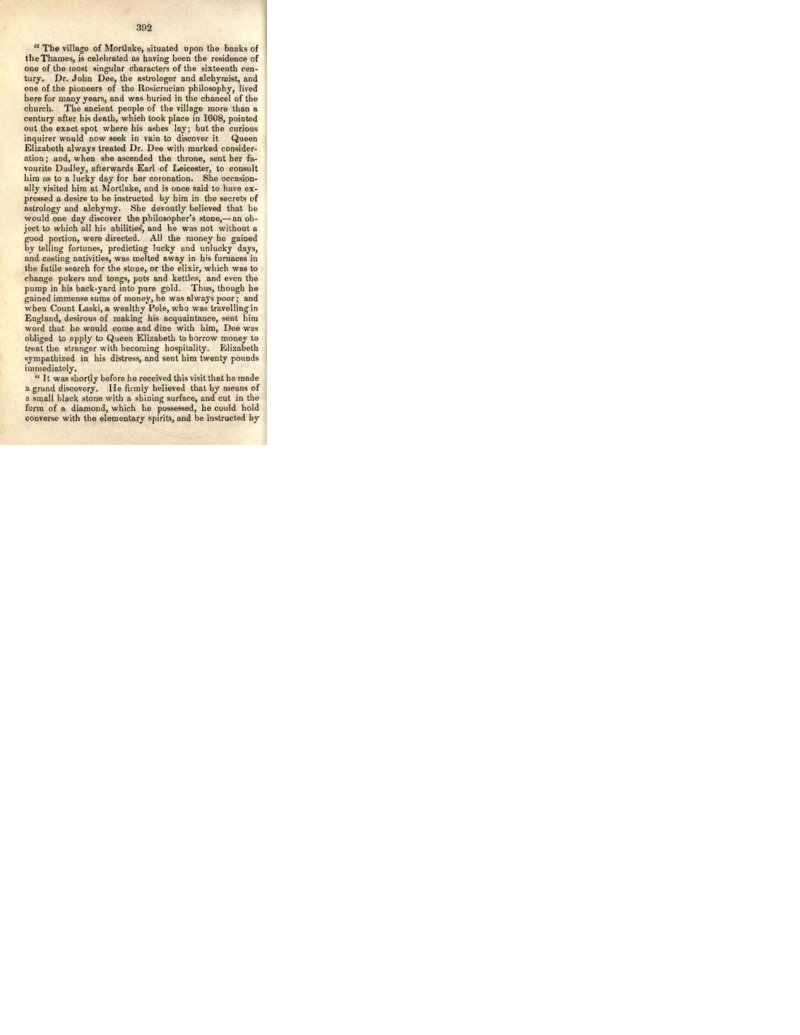J. Mitchell and John Dickie present a 16th century example of "magical" stones being used in a religious context in England.
- Type
- Book
- Source
- John Dickie Non-LDS
- Hearsay
- Secondary
- Reference
J. Mitchell and John Dickie, The Philosophy of Witchcraft (Glasgow: Murray and Stewart, 1839), 392-93
- Scribe/Publisher
- Murray and Stewart
- People
- John Dickie, J. Mitchell
- Audience
- Reading Public
- Transcription
"The village of Mortlake, situated upon the banks of the Thames, is celebrated as having been the residence of one of the most singular characters of the sixteenth century. Dr. John Dee, the astrologer and alchymist, and one of the pioneers of the Rosicrucian philosophy, lived here for many years, and was buried in the chancel of the church. The ancient people of the village more than a century after his death, which took place in 1608, pointed out the exact spot where his ashes lay; but the curious inquirer would now seek in vain to discover it. Queen Elizabeth always treated Dr. Dee with marked consideration; and, when she ascended the throne, sent her favourite Dudley afterwards Earl of Leicester, to consult him as to a lucky day for her coronation. She occasionally visited him at Mortlake, and is once said to have expressed a desire to be instructed by him in the secrets of astrology and alchymy. She devoutly believed that he would one day discover the philosopher's stone,--an object to which all his abilities, and he was not without a good portion, were directed. All the money he gained by telling fortunes, predicting lucky and unlucky days, and casting nativities, was melted away in his furnaces in the futile search for the stone, or the elixir, which was to change pokers and tongs, pots and kettles, and even the pup in his back-yard into pure gold. Thus, though he gained immense sums of money, he was always poor; and when Count Laski, a wealthy Pole, who was travelling in England, desirous of making his acquaintance, sent him word that he would come and dine iwth him. Dee was obliged to apply to Queen Elizabeth to borrow money to treat the stranger with becoming hospitality. Elizbeth sympathized in his distress, and sent him twenty pounds immediately.
"It was shortly before he received this visit that he made a grand discovery. He firmly believed that by means of a small black stone with a shining surface, and cut in the form of a diamond, which he possessed, he could hold converse with the elementary spirits, and be instructed by them in all the secrets of science, and all the mysteries of nature. He has himself left a most extraordinary narrative of his conversations with the spirits; part of which was published after his death by Dr. Casaubon, and the remainder of which may still be seen among the manuscripts in the British Museum. He says, that was he was one day in November 1852, sitting in his study at Mortlake, engaged in fervent prayer, the angel Uriel appeared at his window, and gave him a translucent stone, into which he might summon the angels, and ask them questions whenever he pleased.
- Citations in Mormonr Qnas
The B. H. Roberts Foundation is not owned by, operated by, or affiliated with the Church of Jesus Christ of Latter-day Saints.

